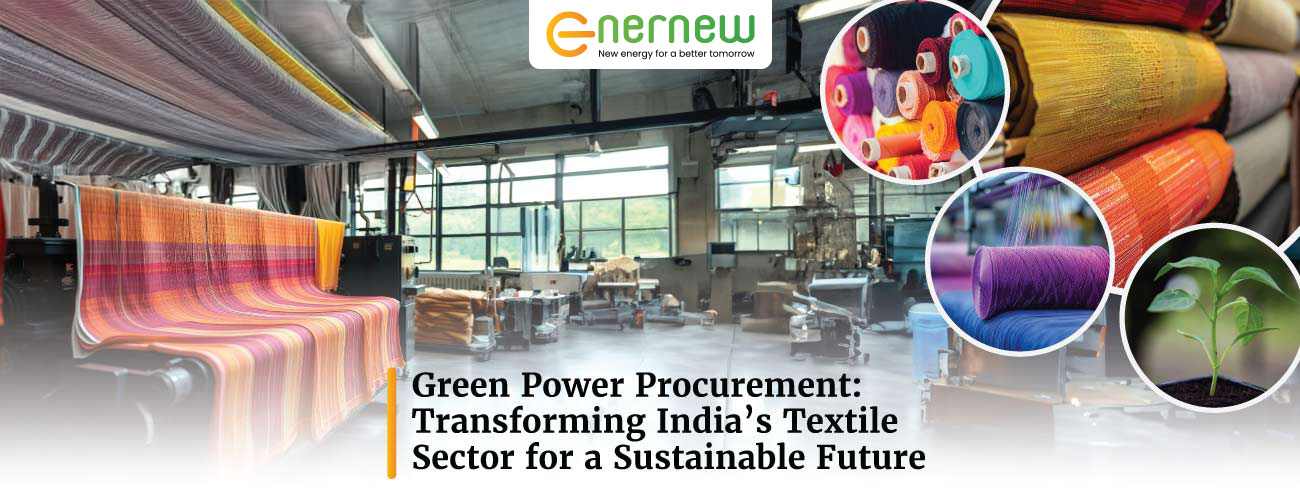Green Power Procurement: Transforming India’s Textile Sector for a Sustainable Future

📑 Table of Contents
India’s textile industry, an integral aspect of the nation’s economy, is undergoing a significant transformation. As global markets and consumers increasingly demand sustainable products, the textile sector is embracing green power procurement to reduce its environmental impact, remain competitive, and align with emerging regulations. This shift toward renewable energy is not just a mere option; it is becoming essential for the industry’s overall growth.
The Scale and Impact of India’s Textile Industry
India’s textile sector is among the world’s largest, valued at ₹14.3 lakh crores (US$172.4 billion) in FY2024. It provides direct employment to 45 million people and indirect employment to another 60 million, making it a vital source of livelihood. The industry contributes approximately 2.3% to India’s GDP and accounts for 12% of the country’s total exports.
The sector is highly diverse, spanning textiles and apparel, technical textiles, and home textiles. Cotton dominates as the primary raw material, with India being the world’s largest cotton producer. Notably, micro, small, and medium enterprises (MSMEs) contribute 70-75% of the sector’s output, underscoring the importance of scalable and accessible sustainability solutions.
Environmental Challenges and Energy Consumption
Modernization has led to increased adoption of electricity-based machinery, boosting productivity but also escalating energy consumption. In 2024, the textile sector consumed 16.68 TWh of electricity, ranking as the fifth-largest industrial energy consumer in India. The industry’s carbon footprint is significant, responsible for an estimated 42–67 million tons of CO₂ emissions annually-about 5-8% of India’s total industrial emissions. Globally, textiles contribute 6-8% of industrial carbon emissions, highlighting the urgent need for decarbonization.
Global Pressures and Regulatory Changes
International trade is increasingly shaped by sustainability mandates. The European Union’s Carbon Border Adjustment Mechanism (CBAM) and similar regulations require exporters to demonstrate reduced carbon footprints and adherence to environmental, social, and governance (ESG) standards. Major global brands now demand that suppliers use renewable energy, recycle materials, and minimize water and chemical usage. For Indian textile exporters, aligning with these requirements is crucial to maintaining and expanding market access.
Leading global clothing brands like H&M and Zara, which have a strong presence in India, are pushing sustainability through numerous initiatives across their supply networks. Both brands have shifted towards using recycled materials, such as recycled polyester, linen, wool, and cotton to reduce their environmental impact.
In addition, they are implementing eco-friendly innovations like waterless dyeing methods. Their commitment to clean energy is also notable, H&M sourced 94% of its electricity from renewable sources by 2023 and aims to reach 100% by 2030, while Zara has set a goal of using 80% renewable energy across all its global operations by 2025.
Government Policies Supporting Green Transition
The Indian government has recognized the need for a sustainable textile sector, introducing the Textile Policy 2024 with a strong focus on:
Sustainability: Promoting green manufacturing, circular economy practices, and emission reductions.
Innovation: Supporting research and development in smart and sustainable textiles.
Investment Incentives: Offering financial support and simplifying regulations to attract investments in sustainable practices.
Skill Development: Training workers for modern, eco-friendly textile processes.
Export Promotion: Facilitating access to global markets and reducing trade barriers.
State governments are also encouraging renewable energy adoption. Maharashtra, for example, provides capital subsidies for textile units installing solar projects up to 4 MW, while Haryana offers financial support for MSMEs to adopt rooftop solar. These incentives are crucial for making green energy more accessible and economically viable across the industry.
Pathways to Green Power Procurement
1. On-Site Renewable Installations
Textile units are increasingly installing rooftop and ground-mounted solar panels to generate electricity on-site. This approach reduces reliance on fossil fuels, lowers operational costs, and greenhouse gas emissions. Even small and medium enterprises are finding rooftop solar to be a practical and scalable solution.
2. Open Access and Off-Site Procurement
Larger textile manufacturers are procuring renewable energy from off-site solar and wind parks through open access mechanisms. This allows for greater flexibility and scale, particularly for facilities with high energy demands or limited space for on-site installations.
3. Energy Efficiency and Process Optimization
Alongside renewable energy, textile companies are implementing energy management systems and optimizing production processes. These measures further reduce energy consumption and emissions, contributing to overall sustainability goals.
Benefits of Green Power Procurement
Adopting renewable energy and improving energy efficiency offer multiple advantages:
Reduced Carbon Footprint: Directly cuts greenhouse gas emissions, supporting compliance with global standards.
Cost Savings: Lowers electricity bills and protects manufacturers from the unpredictability of fossil fuel prices.
Enhanced Market Access: Meets the sustainability requirements of international buyers and regulators.
Stronger Brand Reputation: Demonstrates environmental responsibility to consumers and investors.
Long-Term Resilience: Future-proofs businesses against evolving regulations and market expectations.
The Road Ahead
India’s textile sector is projected to grow to ₹21 lakh crores (US$250 billion) by 2030. To ensure this growth is sustainable, the industry must:
-
Accelerate the adoption of renewable energy, both on-site and through open access.
-
Invest in energy efficiency and advanced management systems.
-
Leverage government incentives and supportive policies.
-
Align with global sustainability standards and best practices.
Conclusion
As India’s textile industry embraces sustainability, partnering with experienced renewable energy providers is key. Enernew, backed by a 45+ year legacy of Sriram Cables, offers end-to-end solar solutions—from on-site rooftop systems to off-site open access solar parks. With extensive experience in partnering up with more than 50 companies and executing over 100 MWp+ of solar projects, Enernew ensures efficient project delivery, regulatory support, and long-term cost savings, giving you the best return on your investment. Schedule a consultation today!

